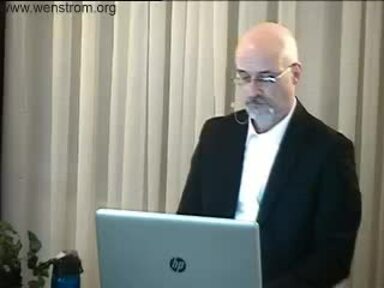Haggai: Introduction-Structure, Text and Themes

Bill Wenstrom
Haggai Introduction • Sermon • Submitted • Presented • 42:46
0 ratings
· 3,355 viewsHaggai: Introduction-Structure, Text and Themes
Files
Notes
Transcript
Sermon Tone Analysis
A
D
F
J
S
Emotion
A
C
T
Language
O
C
E
A
E
Social
The structure of Haggai is built around the four messages contained in the book.
Each presents the date and divine origin of the prophecy as well as the recipients.
The first message was delivered by Haggai on the first day of the sixth month of King Darius’ second year, which was Elul 1 according to the Jewish calendar, which in our modern Julian calendar was August 29, 520 B.C. (Hag. 1:1-11).
It was addressed to Zerubbabel, the governor of Judah and Joshua the high priest.
This message accuses the Jewish remnant of abandoning the rebuilding of the Lord’s temple (1:2-6), which is followed by an exhortation for them to rebuild again (1:7-8).
The Lord asserts that this failure to complete this project is the reason why they have been impoverished since their return from exile (1:9-11).
The remnant responds to the message by beginning to work on this rebuilding project (1:12-15).
The second message was also delivered to Zerubbabel and Joshua the high priest during the twenty-first day of the seventh month Darius’ second year (Hag. 2:1-9).
This was the Jewish month Tishri, which according to our modern calendar would be October 17, 520 B.C.
The twenty-first day of Tishri marked the seventh day of the Feast of Tabernacles (Num 29:32–34).
It also coincided with the date 440 years earlier (960 b.c.) when Solomon finished building his temple (1 Kgs 6:38; 8:2)[1] (Hag. 2:1).
In this message, the Lord through Haggai declares that the glory of this rebuilt temple will be superior to the glory of Solomon’s temple.
The third message delivered by Haggai to the priests of the Law was on the twenty-fourth day of the ninth month of Darius’ second year, which was the twenty-fourth day of the Jewish month Kislev, which in our Julian calendar would be December 18, 520 B.C. (Hag. 2:10-19).
This message asserts that the Jewish remnant is defiled by sin (2:11-14).
The Lord asserts that their poor harvests are the direct result of their disobedience to His law (2:15-17).
However, the Lord also declares that He will bless them as they rebuild His temple (2:18-19).
The fourth and final message was delivered by Haggai to Zerubbabel only on the twenty-fourth day of the ninth month of Darius’ second year, which would be the twenty-fourth day of the Jewish month Kislev, which is December 18, 520 B.C. in our modern calendar (Hag. 2:20-23).
This message contains a Messianic prophecy.
The Lord proclaims in this message that He will judge the Gentile nations in the future (2:21-22).
He also declares that He will restore the Davidic kingdom (2:23).
There are not many problems with the text of book of Haggai.
Thus, it has not been the subject of much controversy regarding its text.
The theme of the book of Haggai is one which the church can readily make application here in the twenty-first century, namely priorities.
The Lord and in particular obedience to the Lord was not the number one priority for the remnant of Judah upon their return from exile.
This was demonstrated by their complete failure to complete the task of rebuilding the temple, which would serve as the place in the nation to worship the Lord.
The Lord through the prophet Haggai confronts the priests regarding the ceremonial uncleanness of the remnant which demonstrated their disobedience to His Law (cf. Hag. 2:11-19).
The Lord implores them to consider their priorities.
Therefore, the book of Haggai teaches the church as it did Old Testament Israel that God’s people must prioritize their lives so that obedience to the Lord’s commands and prohibitions is their number one priority rather than placing priorities upon self.
Another theme of Haggai, which is tied to priorities, is obedience to God.
Several times Haggai mentions the consequences for disobedience (cf. Hag. 1:6, 11; 2:16-17).
The prophet also mentions the consequences for obedience.
God graciously provides the energy or enthusiasm (1:14), strength (2:4-5) and resources (2:8) to do His will when the remnant of Judah obey Him (1:12).
He also promised the post-exilic community that He would bless with His presence (2:9), peace (2:9) and material prosperity (2:19) if they obey Him.
Lastly, the Messiah is another theme contained in the book of Haggai.
Chapter 2 asserts that His glory would fill the rebuilt temple (2:9), which will be fulfilled in history by Jesus Christ during His millennial reign.
In Haggai 2:23, the Lord made Zerubbabel his “signet ring” as a guarantee that the Messiah would come.
The “signet ring” was a seal of royal authority or personal ownership.
Zerubbabel was owned as the Lord’s “signet ring” in his representative position as the son of David, not for personal fulfillment in his own lifetime but for messianic fulfillment in the kingdom of the final Son of David (cf. Luke 1:32–33).
The reference to shaking the earth and sky and overthrowing royal thrones and shattering earthly kingdoms as well as overthrowing chariots and their riders falling as people kill each other is a reference to the Second Advent of Jesus Christ.
[1] Biblical Studies Press. (2005). The NET Bible First Edition; Bible. English. NET Bible.; The NET Bible. Biblical Studies Press.